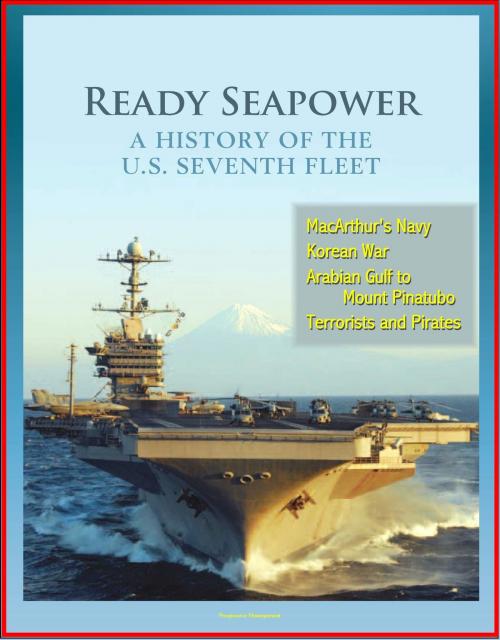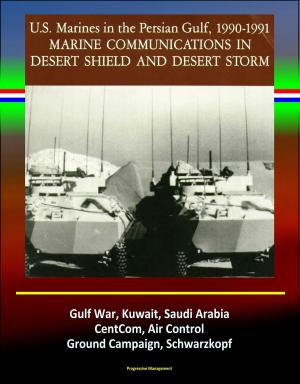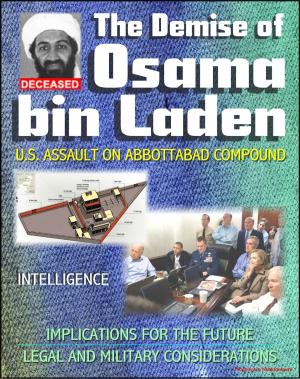Ready Seapower: A History of the U.S. Seventh Fleet - MacArthur's Navy, Korean War, Arabian Gulf to Mount Pinatubo, Terrorists and Pirates
Nonfiction, History, Military, Naval| Author: | Progressive Management | ISBN: | 9781301995547 |
| Publisher: | Progressive Management | Publication: | January 25, 2013 |
| Imprint: | Smashwords Edition | Language: | English |
| Author: | Progressive Management |
| ISBN: | 9781301995547 |
| Publisher: | Progressive Management |
| Publication: | January 25, 2013 |
| Imprint: | Smashwords Edition |
| Language: | English |
The Naval History and Heritage Command published this history to enhance our understanding of the pivotal role played by the U.S. Seventh Fleet in the Western Pacific from World War II through 2010. This project is in keeping with the Command's ongoing efforts to provide naval personnel with historical information and analysis that directly support their global mission. No naval command has done more than the Seventh Fleet to defend and promote American interests in Asia. This "fighting fleet" was in the forefront of U.S. forces involved in the Pacific campaigns of World War II and the conflicts in Korea, Vietnam, and the Arabian Gulf. In the last half of the 20th century and the first decade of the 21st century, the Seventh Fleet has stood as a bulwark against aggression and partnered with America's Asian allies to maintain peace and stability in this vital region. Whether combating conventional forces, guerrillas, insurgents, pirates, or terrorists, Seventh Fleet Sailors have routinely displayed exceptional courage and dedication, serving also as ambassadors for America's core values of freedom, democracy, free market enterprise, and respect for human rights.
U.S. interest in the Far East dates from the earliest years of the republic, when American merchant ships sailed across the vast Pacific to ply their trade in the ports of China, the Philippines, Indochina, and the East Indies. Warships of the U.S. Navy followed soon afterward to protect those commercial carriers and to promote American diplomatic interests in Asia. The U.S. Seventh Fleet, successor to the Asiatic Squadron and Asiatic Fleet of the 19th and early 20th centuries, began making its own naval history in the early days of World War II. Unique among the nation's naval forces, the fleet has taken part in all the major conflicts and most of the crises and confrontations of the last six decades. It has defended U.S. interests and worked with America's Asian alliances to deter aggressors and maintain peace and stability in the region. The fleet's Sailors have provided humanitarian assistance and disaster relief to numerous countries devastated by natural and manmade disasters.
Contents * Foreword * Chronology * Introduction. * Chapter 1 * MacArthur's Navy * Chapter 2 * Weathering Postwar Turmoil in Asia * Chapter 3 * Fighting the Korean War * Chapter 4 * Deterring Conflict in the Far East * Chapter 5 * Combat and Confrontation * Chapter 6 * Old Enemies and New Friends * Chapter 7 * From the Arabian Gulf to Mount Pinatubo * Chapter 8 * Safeguarding the Peace * Chapter 9 * Terrorists, Pirates, and Weapons Proliferators * Chapter 10 * Partners and Adversaries * Appendix Commanders, U.S. Seventh Fleet * Abbreviations * Acknowledgments * Suggested Reading
The Naval History and Heritage Command published this history to enhance our understanding of the pivotal role played by the U.S. Seventh Fleet in the Western Pacific from World War II through 2010. This project is in keeping with the Command's ongoing efforts to provide naval personnel with historical information and analysis that directly support their global mission. No naval command has done more than the Seventh Fleet to defend and promote American interests in Asia. This "fighting fleet" was in the forefront of U.S. forces involved in the Pacific campaigns of World War II and the conflicts in Korea, Vietnam, and the Arabian Gulf. In the last half of the 20th century and the first decade of the 21st century, the Seventh Fleet has stood as a bulwark against aggression and partnered with America's Asian allies to maintain peace and stability in this vital region. Whether combating conventional forces, guerrillas, insurgents, pirates, or terrorists, Seventh Fleet Sailors have routinely displayed exceptional courage and dedication, serving also as ambassadors for America's core values of freedom, democracy, free market enterprise, and respect for human rights.
U.S. interest in the Far East dates from the earliest years of the republic, when American merchant ships sailed across the vast Pacific to ply their trade in the ports of China, the Philippines, Indochina, and the East Indies. Warships of the U.S. Navy followed soon afterward to protect those commercial carriers and to promote American diplomatic interests in Asia. The U.S. Seventh Fleet, successor to the Asiatic Squadron and Asiatic Fleet of the 19th and early 20th centuries, began making its own naval history in the early days of World War II. Unique among the nation's naval forces, the fleet has taken part in all the major conflicts and most of the crises and confrontations of the last six decades. It has defended U.S. interests and worked with America's Asian alliances to deter aggressors and maintain peace and stability in the region. The fleet's Sailors have provided humanitarian assistance and disaster relief to numerous countries devastated by natural and manmade disasters.
Contents * Foreword * Chronology * Introduction. * Chapter 1 * MacArthur's Navy * Chapter 2 * Weathering Postwar Turmoil in Asia * Chapter 3 * Fighting the Korean War * Chapter 4 * Deterring Conflict in the Far East * Chapter 5 * Combat and Confrontation * Chapter 6 * Old Enemies and New Friends * Chapter 7 * From the Arabian Gulf to Mount Pinatubo * Chapter 8 * Safeguarding the Peace * Chapter 9 * Terrorists, Pirates, and Weapons Proliferators * Chapter 10 * Partners and Adversaries * Appendix Commanders, U.S. Seventh Fleet * Abbreviations * Acknowledgments * Suggested Reading















